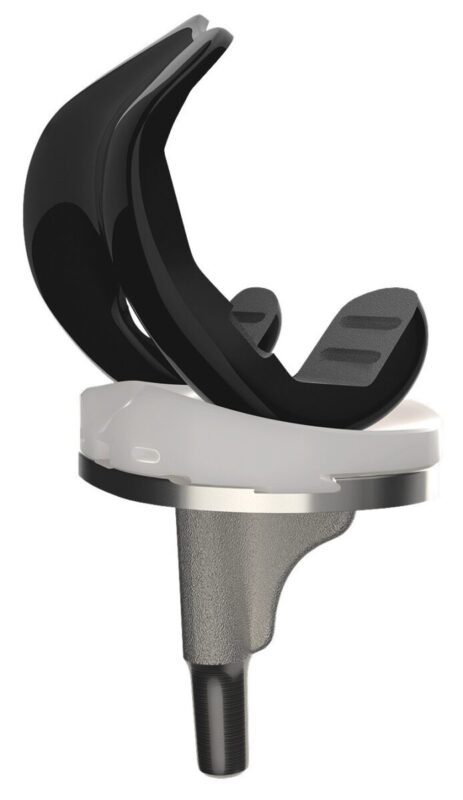JOURNEY II Medial Dished System for total knee arthroplasty was performed by Dr. Ran Schwarzkopf, Orthopedic Adult Hip and Knee Reconstruction at NYU Langone Health.
JOURNEY II Medial Dished System for total knee arthroplasty further completes the JOURNEY II portfolio by offering a tibial insert that can provide more normal kinematics, or motion, in both cruciate-retaining and cruciate-sacrificing procedures.1-5*
Recent total knee implants are designed to try and better replicate this motion found in a healthy knee which has been shown to improve both patient satisfaction and performance. However, only Smith+Nephew’s JOURNEY II TKA System has been shown to restore anatomical shape, position and motion.2-6 This anatomical design has led to a smoother recovery, improved function and higher patient satisfaction.5-12,**
Dr. Schwarzkopf commented, “Adding a medial dished component to the JOURNEY II for total knee arthroplasty portfolio is a significant development and expands the options I’m able to offer my patients. It allows me to optimize the kinematics for my patient’s while also providing good stability in either a cruciate-retaining or cruciate-sacrificing total knee replacement procedure.”
JOURNEY II MD is designed with a more constraining medial side, compared to a standard tibial insert, to promote more normal kinematics and provide additional stability if the PCL has been resected or is not in good condition.1-5* Over the last few years, the concept of a tibial insert that helps drive better knee kinematics has been rapidly growing and JOURNEY II has led in this space. The Medial Dished insert is the next step of innovation allowing Smith+Nephew to offer a unique solution in this space.
“We are very excited about the launch JOURNEY II Medial Dished,” said Randy Kilburn, Executive Vice President & General Manager, Orthopaedic Reconstruction, Robotics and Digital for Smith+Nephew. “Our customers have expressed an interest in medial dished inserts and we are pleased to provide new treatment options that expand the clinical indications of the already successful JOURNEY II Knee System”.
Smith+Nephew’s JOURNEY II Medial Dished is now available in the United States for total knee replacement.
References:
- Smith+Nephew 2021. TM-21-148.
- Iriuchishima T, Ryu K. A Comparision of Rollback Ratio between Bicruciate Substituting Total Knee Arthroplasty and Oxford Unicompartmental Knee Arthroplasty. J Knee Surg. 2018;31(6):568-572.
- Murakami K, Hamai S, Okazaki K, et al. Knee kinematics in bi-cruciate stabilized total knee arthroplasty during squatting and stair-climbing activities. J Orthop. 2018;15(2):650-654.
- Carpenter RD, Brilhault J, Majumdar S, Ries MD. Magnetic resonance imaging of in vivo patellofemoral kinematics after total knee arthroplasty. Knee. 2009;16(5):332-336.
- Smith LA, Nachtrab J, LaCour M, et al. In Vivo Knee Kinematics: How Important Are the Roles of Femoral Geometry and the Cruciate Ligaments? J Arthroplasty. 2021;36:1445-1454.
- Grieco TF, Sharma A, Dessinger GM, Cates HE, Komistek RD. In Vivo Kinematic Comparison of a Bicruciate Stabilized Total Knee Arthroplasty and the Normal Knee Using Fluoroscopy. J Arthroplasty. 2018;33(2):565-571.
- Murakami K, Hamai S, Okazaki K, et al. In vivo kinematics of gait in posterior-stabilized and bicruciate-stabilized total knee arthroplasties using image-matching techniques. Int Orthop. 2018;42(11):2573-2581.
- Noble PC, Gordon MJ, Weiss JM, et al. Does Total Knee Replacement Restore Normal Knee Function? Clin Orthop Relat Res. 2005;431:157–165.
- Nodzo SR, Carroll KM, Mayman DJ. The Bicruciate Substituting Knee Design and Initial Experience. Techniques in Orthopaedics. 2018;33(1):37-41.
- Takubo A, Ryu K, Iriuchishima T, Tokuhashi Y. Comparison of Muscle Recovery Following Bi-cruciate Substituting versus Posterior Stabilized Total Knee Arthroplasty in the Asian Population. J Knee Surg. 2017;30(7):725-729.
- Mayman DJ, Patel AR, Carroll KM. Hospital Related Clinical and Economic Outcomes of a Bicruciate Knee System in Total Knee Arthroplasty Patients. Poster presented at: ISPOR Symposium;19-23 May, 2018; Baltimore, Maryland, USA
- Kosse NM, Heesterbeek PJC, Defoort KC, Wymenga AB, Hellemondt GG. Minor adaptations in implant design bicruciate-substituted total knee system improve maximal flexion. Poster presented at: 2nd World Arthroplasty Congress;19-21 April, 2018; Rome, Italy.
*Based on JOURNEY II BCS and CR Evidence
**Compared to non-JOURNEY II knees

